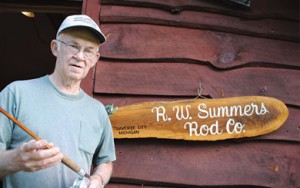
Ours is a mass-production society, and those of us who live in Michigan have been smack in the middle of it ever since Henry Ford first dreamed up the assembly line.
The advantages of mass production are obvious—not only are the costs of consumer goods reduced, but service and parts become readily available, too. Still, there are plenty of folks who are willing to pay more—sometimes significantly more—for unique items. That is especially true for sporting goods.
Bob Summers knows this and has made a living his whole life by providing sportsmen with something truly unique: handmade bamboo fly rods.
Summers, of Traverse City, was bitten by the fly-fishing bug as a youth, and as a teenager in 1956 took an after-school job at a Detroit fly rod shop. He hasn’t stopped making fly rods since then.
After 17 years working at the company founded by the legendary Paul Young, Summers decided it was time to go out on his own. Today, he is among the best-known bamboo fly-rod builders in the world, with a customer base that extends to Europe and Asia.
Although most fly rods are now made from graphite, some aficionados prefer bamboo because of the tradition behind them. Others say simply that bamboo rods “feel more alive” than modern graphite rods.
“There’s definitely a different feel,” says Summers, 74. “It’s a slower action. It’s heavier in your hand than a graphite rod for the same size line, but I kind of like the feel in your hand.”
Summers compares the two rods to using a heavy hammer or a light one—in the end, both will get the job done—it’s just a matter of personal preference.
“Bamboo isn’t for everyone,” Summers says. “The stroke of the rod is slower. I wouldn’t say it’s ‘better.’ I prefer to say it’s different. Some people fall in love with it right away. Some people don’t. “A person’s got to really fish a lot to appreciate it,” he adds.
Bamboo—also known as cane—is a tropical or semi-tropical grass with a hollow stem and woody exterior that provides both the strength and flexibility required for fly rods. It was the premier fly rod material before the advent of fiberglass (which eventually gave way to graphite) and is still highly prized by traditional fly fishermen. The best cane for fly rods is Tonkin cane, from South China, and it’s the only bamboo Summers has ever used in his craft.
Summers begins the rod-building process with lengths of cane that measure anywhere from 2 to 2 ½ inches in diameter. He immediately splits them lengthwise—to keep them from cracking on their own—and heat-treats them over an open flame to temper the cane and give it that rich caramel color. He then cuts lengths of cane into strips (about ¼-inch wide) and machines the lengths into 60-degree triangles that taper lengthwise. The strips are glued together into a six-sided section of rod. The lengths of rod are filed smooth, steel-wooled and varnished, at least twice.
Summers typically makes two-piece rods—a butt and a tip—and fabricates all of his own hardware (except for the line guides)—including the reel seats and the nickel silver ferrules that join the sections. Most Summers rods come with two tips, so the angler has a spare should he break it, though he says some of his customers prefer to buy a rod with just one tip so they can put the money they save toward another rod.
“There’s no one rod that does everything best,” Summers explains. “You use different rods if you’re fishing for 8-inch brook trout than you do if you’re fishing for steelhead. You’ve got to have a couple of rods—at least.”
Summers rods aren’t cheap. Prices begin at around $2,100 for a two-tip set, but they are apparently worth the investment; used Summers rods are starting to show up as collectibles, fetching far more than Summers charges for a new one.
“You’ve got to feel alright about that,” he says. “I’m not getting a big head about it, but it’s better than them not being collectibles.”
If you’re thinking about a Summers rod for your angling sweetheart for Christmas, you’re probably out of luck. These rods are in such demand that there’s a waiting list to buy one. But if you order one now, you can have it by next Christmas
Visit rwsummers.com to learn more about Bob Summers and the rods he makes.
– Bob Gwizdz





